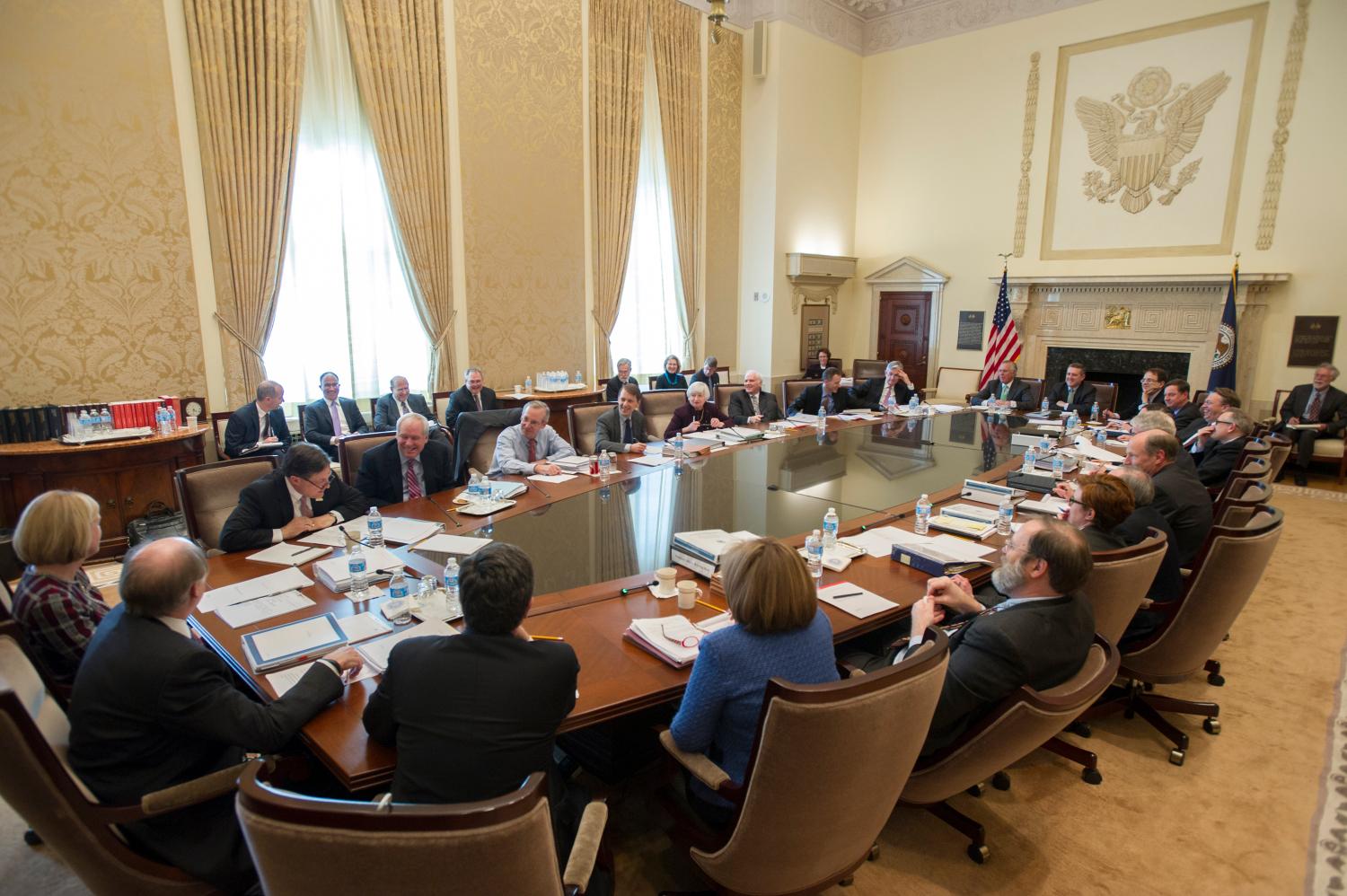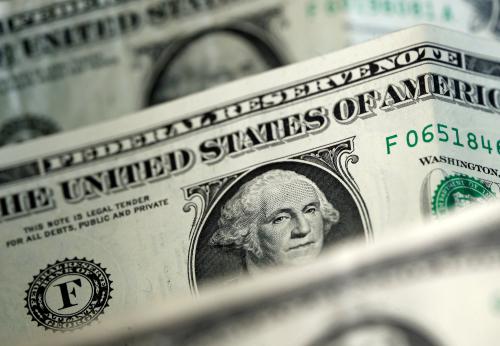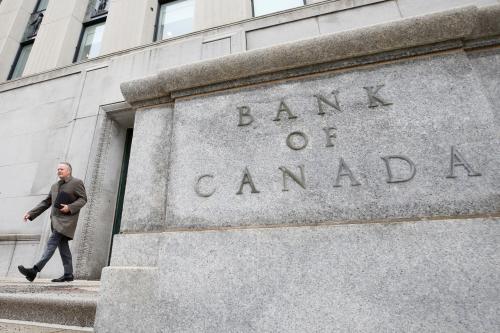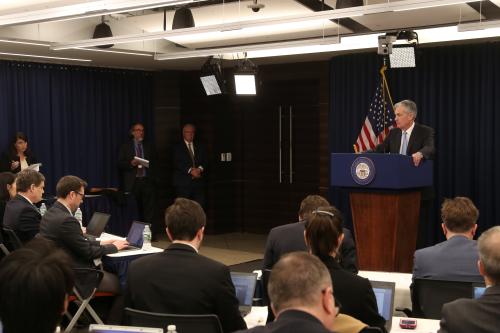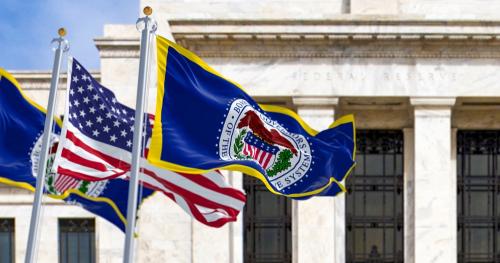Congress charges the Federal Reserve with pursuing “maximum employment” and “stable prices,” but leaves it to the Fed to define those terms. When Alan Greenspan was Fed chair, he once defined price stability as “that state in which expected changes in the general price level do not effectively alter business and household decisions.” In other words, he meant inflation (the change in the prices of goods and services) should be low enough so people don’t think about it in their economic lives. Over the past couple decades, central banks around the world have put a number on that inflation rate—around 2 percent. That was thought to be close enough to zero to be plausibly defined as price stability, especially given the tendency of official price measures to overstate increases in the cost of living, but high enough to ward off unwelcome bouts of deflation or falling prices. Once a few central banks embraced a 2 percent target, it was easier for the rest to pick that number, too. (“[T]he 2 percent target acquired the great advantage of conventionality: central banks could not easily be accused of acting irresponsibly when they had the same inflation target as everyone else,” economist Paul Krugman has noted.)
In 1996, Fed policymakers privately agreed that their target for inflation was 2 percent, but, at Greenspan’s insistence, they didn’t tell anyone. In 2012, at the urging of then-Chair Ben Bernanke, the Fed formally and publicly announced that they were targeting a 2 percent inflation rate. The Fed’s strategy, approved annually by its policy-making Federal Open Market Committee and tweaked a bit since 2012, says:
“The Committee reaffirms its judgment that inflation at the rate of 2 percent, as measured by the annual change in the price index for personal consumption expenditures, is most consistent over the longer run with the Federal Reserve’s statutory mandate. The Committee would be concerned if inflation were running persistently above or below this objective. Communicating this symmetric inflation goal clearly to the public helps keep longer-term inflation expectations firmly anchored, thereby fostering price stability and moderate long-term interest rates and enhancing the Committee’s ability to promote maximum employment in the face of significant economic disturbances.”
In fact, inflation fell short of the Fed’s 2 percent target for much of the past decade.
 Three years after Bernanke persuaded his colleagues to adopt the target, he said, “I don’t see anything magical about targeting 2 percent inflation. My advocacy of inflation targets as an academic and Fed governor was based much more on the transparency and communication advantages of the approach and not as much on the specific choice of target.”
Three years after Bernanke persuaded his colleagues to adopt the target, he said, “I don’t see anything magical about targeting 2 percent inflation. My advocacy of inflation targets as an academic and Fed governor was based much more on the transparency and communication advantages of the approach and not as much on the specific choice of target.”
Today, the 2 percent inflation target is under scrutiny, in part because of fears that framework will hamper the Fed’s ability to fight future recessions. In the early 2000s, economists at the Fed and elsewhere estimated that the inflation-adjusted (or real) neutral interest rate—the short-term interest rate expected to prevail when the economy is at full employment and prices are stable—was around 3 percent. With 2 percent inflation and a 3 percent real neutral rate, then, nominal rates would hover around 5 percent when all was calm. In a recession, the Fed would have plenty of room to cut interest rates by 4 or 5 percentage points as it often does in a recession.
The latest projections of the long-run neutral real rate are much lower—perhaps 1 percent or even less. Most Fed officials project that the nominal short-term interest rate, the one the Fed influences most directly, will be between 2.8 percent to 3.0 percent in the long run, well below the 1960-2007 average of 6 percent. Because getting interest rates much below zero is impossible, the Fed won’t be able to cut rates by 4 or 5 percentage points when the next recession arrives, and that could prolong the pain of any downturn.
The Fed cut short-term interest rates to zero in 2008 and, to the surprise of almost everyone, kept them there for seven years. Boston Federal Reserve Bank President Eric Rosengren says that when the intellectual groundwork for the 2 percent target was laid, he and others “didn’t think we were going to hit the zero lower bound very often and we didn’t think it was going to be very hard to get off that zero lower bound.” Today, Fed policymakers and outside economists anticipate interest rates are likely to hit zero repeatedly over the next few decades
Abandoning the 2 percent inflation target for a higher target or a different regime would not be easy. “We’re not starting with a blank slate,” says Bernanke. “We do have a framework, a 2 percent target in which there is a tremendous amount of investment in the sense of communication, of years of experience and anchoring of expectations around 2 percent inflation targets. The argument that says, ‘Well, what would we do if we start from scratch?’ is interesting for academics but maybe not the most relevant question starting from where we are.”
Today, the 2 percent inflation target is under scrutiny, in part because of fears that framework will hamper the Fed’s ability to fight future recessions.
Nonetheless, several current and former Fed policymakers advocate examining the merits of keeping, changing or replacing the 2 percent inflation-target framework so the Fed can better to manage the economy in the years ahead. The choice matters: The framework guides Fed officials as they decide when and how much to move interest rates. With a different framework, the Fed might not have been raising short-term interest rates so much in 2017 and 2018. The framework influences financial market expectations and, thus, the level of longer-term interest rates and the stock market. If credible, a framework gives businesses and consumers, borrowers and lenders, an idea of how much inflation to factor into their decisions. And, importantly in a democracy, a well-explained framework gives citizens and their elected representatives a yardstick against which to measure the Fed’s performance.
This report seeks to shed light on two questions: What are the arguments for keeping, changing or replacing the 2 percent inflation target? And if it were to be replaced, what should replace it?
Raise the inflation target
One alternative to the Fed’s current approach would be to keep targeting the inflation rate, but to raise the target from the current 2 percent, perhaps to 3 percent or 4 percent. The case for this is straightforward: When financial markets anticipate more inflation, nominal interest rates are generally higher. And when nominal interest rates are higher, the Fed has more room to cut them at times when the economy slows too much or heads for recession. This would reduce the likelihood that short-term interest rates would fall to zero, a circumstance that the Fed would prefer to avoid because it makes using monetary policy to revive a struggling economy more difficult.
The choice of 2 percent for an inflation target may have been wise when it was made decades ago, but may not be the best choice for today’s economy. “Even if 2 percent was exactly the right number based on what we knew in 2006, it cannot be the right number today,” says Olivier Blanchard, an MIT economics professor emeritus now at the Peterson Institute for International Economics who drew criticism in 2010 when, as chief economist at the International Monetary Fund, he publicly suggested lifting the target. What’s changed? The real neutral rate of interest (the one that’ll prevail when all is calm, unemployment is low and prices are stable) is believed to be lower than it used to be, increasing the risk that nominal interest rates will be constrained by the zero lower bound. Projecting the long-run real neutral rate of interest is difficult; it could turn out to be higher or lower than the current consensus forecast. Blanchard argues that the Fed would be wise to worry more about the possibility that the neutral rate will turn out to be lower than expected than that it’ll be higher than expected; the former poses much bigger problems for monetary policy makers, he says. And, he adds, there’s no sound economic research that shows 2 percent to be the economically optimal inflation rate nor that demonstrates that the costs to economic efficiency of 3 percent or 4 percent inflation are significantly greater than the costs of 2 percent inflation.
These arguments do not meet with universal applause. As noted earlier, Bernanke acknowledges that it might have been better to pick a higher number initially, but now that 2 percent is widely seen as the definition of “price stability,” it’d be unwise and difficult to change it. “The Federal Reserve is not going to adopt the 4 percent inflation target. It’s just not going to happen,” he says flatly. Some members of Congress consider anything higher than 2 percent a violation of the Fed’s “price stability” mandate and suggest any upward move would require a change in the law. William Dudley, the former president of the New York Fed, agrees: “I doubt that a higher inflation target would be viewed as consistent with the Federal Reserve’s Congressional mandate to pursue price stability,” he has said.
Blanchard himself concedes that lifting the target would sacrifice a big advantage of the 2 percent target: Inflation is no longer salient in Americans’ economic lives. “Inflation was on our mind when we had to take mortgages and inflation was 5 percent or 10 percent and we really had to think about it and everybody had to think about it in some ways,” he says. “I think most of us as individuals, not as professional economists, have not thought much about inflation in the last few years. It is just very low, and that’s exactly why Greenspan wanted basically a level of inflation which is sufficiently low that nobody cares.” As a result, the Fed can confidently cut interest rates when necessary without prompting consumers, businesses or markets to anticipate that inflation will zoom in the future. “I suspect if we move to 4 percent,” Blanchard adds, “then people will be more aware of movements in inflation, and then get into what we’ve seen in the past: expectations of inflation adjusting to movements in inflation faster and making the job of the central bank more difficult.”
Some economists argue that lifting the inflation target by a percentage point or two could lead to even more inflation. “It is really more difficult to stabilize inflation at the 4 percent level than at the 2 percent level,” says Frederic Mishkin, a former Fed governor now at Columbia Business School. Adds Bernanke: “Folks would say, well, if we go to 4 percent, why not go to 6 percent. It’d be very difficult to tie down expectations at 4 percent.”
Some economists argue that lifting the inflation target by a percentage point or two could lead to even more inflation.
Laurence Ball of Johns Hopkins University disagrees. “History does not suggest that it would be ‘difficult to tie down expectations’ if inflation rises modestly. Inflation expectations, as measured by surveys, have generally followed actual inflation with a lag. They followed inflation up during the 1960s and 70s, and after that they followed inflation down. If inflation rises to 4 percent, it seems unlikely that expectations will overshoot this level.”
Still others are skeptical about the value of the whole inflation target concept because the Fed for so many years failed to produce 2 percent inflation even with that 2 percent target. Indeed, it’d be easy to ridicule the Fed for promising 3 percent inflation when the Fed had so much trouble getting inflation up to 2 percent. “Whether the goal was to get inflation down, as it used to be in the ‘80s, or to get inflation up, as it has been lately, our models all assume that if the central bankers were pure of heart or, failing that, if they had their hands tied, that magically expectations throughout the economy would be transformed and you could do things like getting inflation up or down without paying output costs,” says Jeffrey Frankel of Harvard University. “I don’t think this discussion among monetary economists has quite adequately acknowledged the extent to which that has failed. They were pure of heart, they really meant it about the 2 percent target and they didn’t achieve it. I think we need to take that into account more.” (The Fed’s favorite measure of inflation, the personal consumption expenditures price index, has climbed at an 1.8 percent annual average since the Greenspan Fed agreed on a 2 percent target in 1996, and at a 1.4 percent annual average over the past decade.)
Bernanke, among others, doubts that a higher inflation target is a good solution to the problem its advocates seek to solve. “First, because it gives you higher inflation all the time, whether you are close to the zero lower bound or not,” Bernanke says. “And, second, when you’re at the zero lower bound, it doesn’t give you any particular additional push to get out of the zero lower bound.”
Similar concerns led Rosengren, the Boston Fed president, to offer an alternative to a permanently higher inflation target. He would have the Fed define a range of inflation rates—say 1.5 percent to 3 percent—that it would find acceptable. The Fed would set a medium-term goal within that range, perhaps revisiting it annually to take account of changing economic circumstances. He calls it “an inflation range with an adjustable inflation target.” His approach would give the Fed more flexibility but would generate unwelcome uncertainty about where inflation is headed. Rosengren figures that long as the Fed keeps inflation within the 1.5 percent to 3 percent band that uncertainty wouldn’t pose much of a problem. William Dudley, the former president of the New York Fed, also has advocated moving to an inflation range of perhaps 1.5 percent to 2.5 percent: “First, it might be viewed as more realistic given that measured inflation will always randomly fluctuate relative to its underlying trend. That is to say, even if the FOMC performs its job exceedingly well, very rarely will the inflation rate, as measured by the PCE price index, be precisely at 2 percent. Second, having a relatively narrow range would send a message that the FOMC is discriminating between two regimes—one in which inflation is within the range and concerns about inflation are low versus another in which inflation is outside the range and concerns about inflation are more elevated.”
Price level target
With an inflation target, the Fed aims at a particular rate of change in prices. An alternative is to target the overall level of prices. The Fed might announce, for instance, that it would aim to keep the price level increasing at a 2 percent annual rate on average over a period of several years. Effectively, under this approach, the Fed would be targeting the average rate of inflation over a long period, rather than quarter to quarter. Monetary policy would consequently aim to offset periods in which inflation is below 2 percent with periods in which inflation is above2 percent, so that, over time, prices would rise by 2 percent on average. Likewise, periods of above-target inflation would be followed by periods of inflation below 2 percent.
Switching to a price level target would be a significant change. The Fed currently looks only forward. Its framework doesn’t take account of whether inflation has been above or below target in the past. It lets bygones be bygones. A price level target, in contrast, looks both backward and forward.
Replacing the 2 percent annual inflation target with a price-level target of 2 percent probably fits cleanly inside the Fed’s legal mandate; in fact, many Americans probably wouldn’t notice much difference. One advocate, John Williams, now president of the New York Fed, argues that price-level target would do better at keeping prices rising at 2 percent over time. “With an inflation target you’re going to be missing your goal for long periods of time,” he says. (In good times, the Fed will be able to hit 2 percent, but it bad times, it’ll likely fall short so the average inflation rate will tend to be lower than 2 percent.) “The price-level targeting rule notices that we’re missing on our inflation target roughly year after year and therefore keeps interest rates lower for longer after a very severe recession where inflation was very low. It basically promises extra stimulus to help guide the economy higher and also bring inflation back,” Williams says.
If successful, a price-level target might be more useful to ordinary Americans than the current inflation target, which the Fed hits in some years and misses in others. “When you’re planning for the future, if you’re buying a car, buying a house, saving for your retirement or your kids’ education, you’d understand what inflation on average will be over the next 10, 20, 30 years,” Williams says. “Those are the kind of horizons that households and businesses often think about.”
Yes, but…
When inflation has been below target for nearly a decade, as it has been lately, anything that prompts the Fed to keep nominal interest rates low and to welcome above-target inflation for a while may sound appealing, particularly to borrowers who get a better deal on a car loan or workers who find jobs more plentiful than otherwise. But consider the opposite circumstance: After a period of above-target inflation, the Fed would promise to keep interest rates—and unemployment—high to engineer a period of below-target inflation. Imagine a young car-buyer learning that the Fed is boosting the rate on her loan to compensate for higher inflation that occurred while she was still riding a bike. Or consider the reaction of a newcomer to the Federal Reserve Board who is told: Well, because the last crew let inflation run too high, you’ve got to vote to raise rates to slow the economy so that inflation gets down to 1 percent.
Advocates of price-level targeting say that the policy could help stabilize the economy if it suffers a demand shock. Say that, for some reason, consumers and businesses pull back on spending, nudging the economy towards recession and bringing the path of prices below the Fed’s target. With a credible price level target, people would expect the Fed to ensure that the inflation rate rises above 2 percent temporarily so that prices get back to the target path. “This increases expected inflation, which means that real interest rates (nominal rates less expected inflation) are lower, providing stimulus to an economy in need of it,” Mishkin, the Columbia economist, argues. He notes that this method works particularly well at the zero-lower-bound.
On the other hand, if the economy is hit by a supply shock, such as an increase in oil prices, it might make more sense to simply accept a one-time increase inflation. As Bernanke notes, “The ‘bygones are not bygones’ aspect of this approach is a two-edged sword. Under price-level targeting, the central bank cannot ‘look through’ supply shocks that temporarily drive up inflation, but must commit to tightening to reverse the effects of the shock on the price level.” Given that this could adversely affect employment and output, the Fed might have trouble convincing people it would really stick to this approach.
Price-level targeting would work well only if public and markets find the Fed to be credible and believe that periods of low inflation will be offset by periods of higher inflation. The case of Japan illustrates the difficulty in doing that; the Bank of Japan has found altering public inflation expectations very tough. Bernanke counters that financial markets, not the average consumer, are the primary target – and their expectations do change when the central bank gives them reason to do so. Influential Swedish economist Knut Wicksell proposed price-level targeting in 1898 and the Swedish Riksbank did experiment with it in the 1930s, but no major central bank has tried it lately. The Bank of Canada recently considered and rejected it. With a smile, Bernanke says “The ideal thing [would be] if we could just persuade New Zealand, which introduced inflation targeting in 1990, to do price level targeting for three or four years so we could all find out how it works. That would be a tremendous benefit to the rest of the world.”
Several observers are uncomfortable with replacing an inflation target with a price-level target, but they advocate something similar in practice. For instance, Mishkin, the former Fed governor now at Columbia, suggests re-defining the target as aiming for an inflation rate of 2 percent over some period, say five years. “You make it very clear that you’re really shooting for a 2 percent long-run target so you keep anchoring those expectations.” he says. William Dudley, the former New York Fed president, agrees: “We should further study how price-level targeting frame works might work in practice. But, it is possible that a simpler approach of committing to keeping the average inflation rate around 2 percent over the medium term might be just as appealing.”
Price-level targeting would work well only if public and markets find the Fed to be credible and believe that periods of low inflation will be offset by periods of higher inflation.
Bernanke, among others, has advocated a variant of price-level targeting: He calls it “temporary price-level targeting.” In normal times, times when short-term interest rates are comfortably above zero, the Fed would stick to the 2 percent inflation target. But the Fed would announce in advance that if rates fell to zero and were stuck there for a while then it would temporarily pursue a price-level target. In other words, after a period of zero interest rates, the Fed would vow to keep rates low for a long time and aim for a period of above-target inflation. If this pledge were understood, believed and anticipated by the public, Bernanke argues, encounters with the zero lower bound would be “shorter, less severe, and less frequent.”
Bernanke cites two ways his approach is better than straightforward price-level targeting: First, when interest rates are away from zero, the current inflation-target framework would remain in place, preserving the benefits that approach has produced. Second, he argues that his approach would be easier to explain to the public; the “communication could remain entirely in terms of inflation goals, a concept with which the public and market participants are already familiar.”
Olivier Blanchard, for one, is unconvinced. “I would much prefer to have inflation just when we need it, but I’m a bit skeptical that it can be done.”
Nominal GDP target
An alternative to targeting inflation or the price level would be to target either the growth rate or the level of nominal Gross Domestic Product, the dollar value of all of the goods and services produced in the economy. This would combine the Fed’s price stability and employment mandates into a single metric.
A framework that targeted the growth rate of GDP would specify some rate – say 4 ½ percent – for nominal GDP growth. If GDP growth came in below this level, the Fed would loosen policy, and if it came in above this level, the Fed would tighten. Alternatively, the Fed could target the level of nominal GDP. This would have the same “look back” feature that price level targeting has. Say that the Fed chose a target of 4½ percent growth in GDP beginning in 2007. The Fed would then expect nominal GDP to rise over time at 4½ percent. If growth fell short of the targeted level, as it did in 2009 and 2010, the Fed would stimulate the economy, and would keep monetary stimulus in place until nominal GDP returned to the path implied by 4 ½ percent annual growth since 2007. Likewise, a period where GDP rose above the targeted path would be followed by higher interest rates to get nominal GDP back to its path.
This idea of targeting nominal GDP is not new. It was first proposed in 1977 by Nobel laureate James Meade, and was particularly appealing to some economists who were looking for an alternative to Milton Friedman’s notion that the Fed should target growth in the money supply. No central bank has formally adopted a nominal GDP target.
Targeting the growth rate of nominal GDP would allow the Fed to communicate and cope with just one target instead of the current two, inflation and employment. “If central banks want to communicate their intentions at a one- to two-year horizon, it would be more effective if they traced that commitment…or that guidance in terms of nominal GDP rather than in terms of CPI inflation,” says Frankel, the Harvard economist. In many ways, nominal GDP is easier to track than many other economic indicators. Once the Fed decided on a target for growth in the level of nominal GDP, it would no longer need to estimate the unemployment rate consistent with price stability or the gap between potential and actual GDP or the neutral real interest rate. In other words, the Fed would need less information to make decisions. “A nominal GDP target would take the focus off of inflation and what its appropriate value should be. Thus, if there needed to be some catch-up inflation and nominal spending to get nominal GDP back to its targeted growth path the Fed could do it with less political pressure,” says David Beckworth of the Mercatus Center at George Mason University.
Targeting the growth rate of nominal GDP would allow the Fed to communicate and cope with just one target instead of the current two, inflation and employment.
A nominal GDP target would, almost automatically, lead the Fed to lower interest rates in bad times – whether bad in terms of economic growth or in terms of too-low inflation – and raise them in good times. It wouldn’t have to diagnose, in real time, the reasons for the deviation from its target. This approach would be particularly valuable at times when the economy is sagging, as it was in 2011 when Christina Romer of the University of California at Berkeley argued: “By pledging to do whatever it takes to return nominal GDP to its pre-crisis trajectory, the Fed could improve confidence and expectations of future growth. Such expectations could increase spending and growth today: Consumers who are more certain that they’ll have a job next year would be less hesitant to spend, and companies that believe sales will be rising would be more likely to invest.”
A nominal GDP target would lead the Fed to increase inflation in a recession or period of very slow growth. In a recession, the public might welcome lower interest rates and higher inflation if that brought down unemployment. But if economic growth were sluggish for a protracted period, as it was following the Great Recession, targeting nominal GDP growth would mean raising the inflation target on a sustained basis. Economists who advocate this approach say that’s a feature, not a bug; essentially, expectations of higher inflation would raise nominal interest rates in periods when real rates are low, reducing the chances that monetary policy will be constrained by the zero lower bound. The public, however, might be unhappy with a prolonged period in which economic growth is slow and inflation high.
Targeting the level, as opposed to the growth rate, of nominal GDP raises some of the same issues raised by targeting the price level: The Fed would have to explain why it is raising or lowering interest rates today because of something that happened yesterday. This framework would have the Fed slow the economy – and raise unemployment – for a time following a period in which the economy had grown above target. This could be a hard sell: You’re unemployed today because we had too many people working last year or you’re paying more for your car loan today because too many people borrowed to buy cars last year.
Then there is the technical challenge. While nominal GDP is observable in principle (unlike, say, concepts like the natural rate of unemployment), in practice nominal GDP data are revised repeatedly before becoming final, sometimes substantially. The mean revision between the initial report of nominal GDP and the one published two months later is greater than 1.2 percentage points. The numbers are revised again when final data are received. Significant revisions to historic data could complicate matters for the Fed if it was using nominal GDP targeting.
The Brookings Institution is committed to quality, independence, and impact.
We are supported by a diverse array of funders. In line with our values and policies, each Brookings publication represents the sole views of its author(s).

